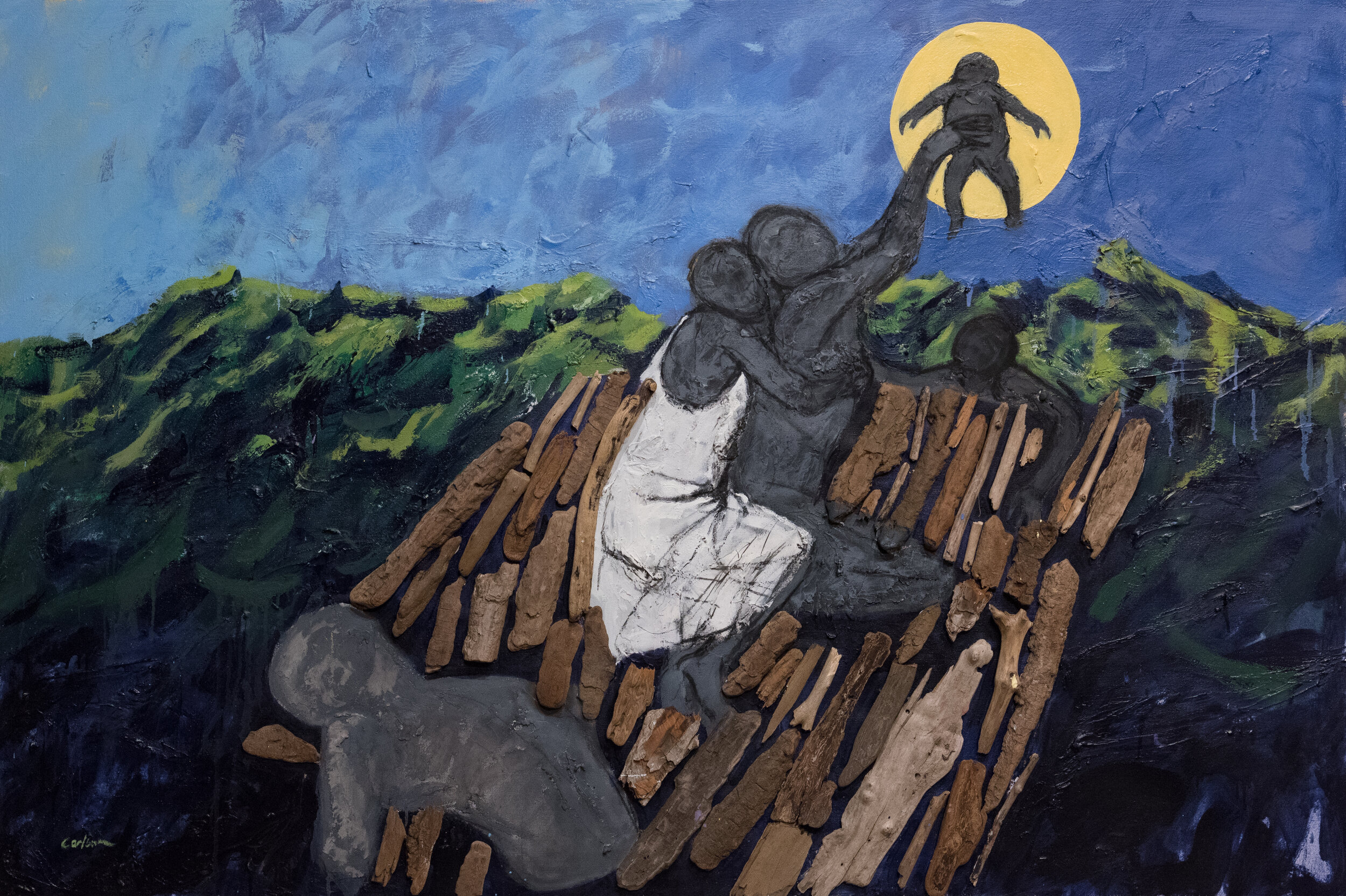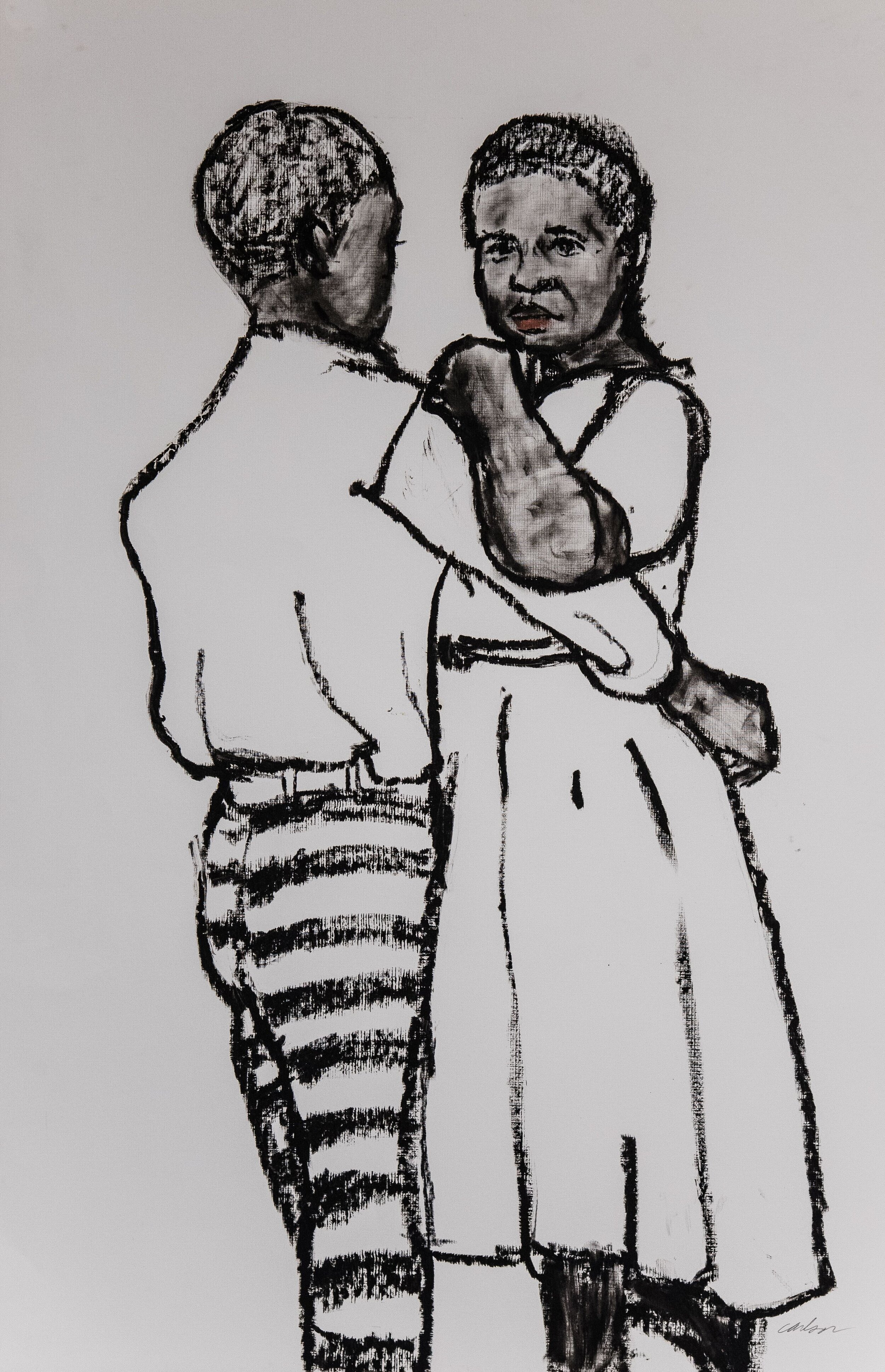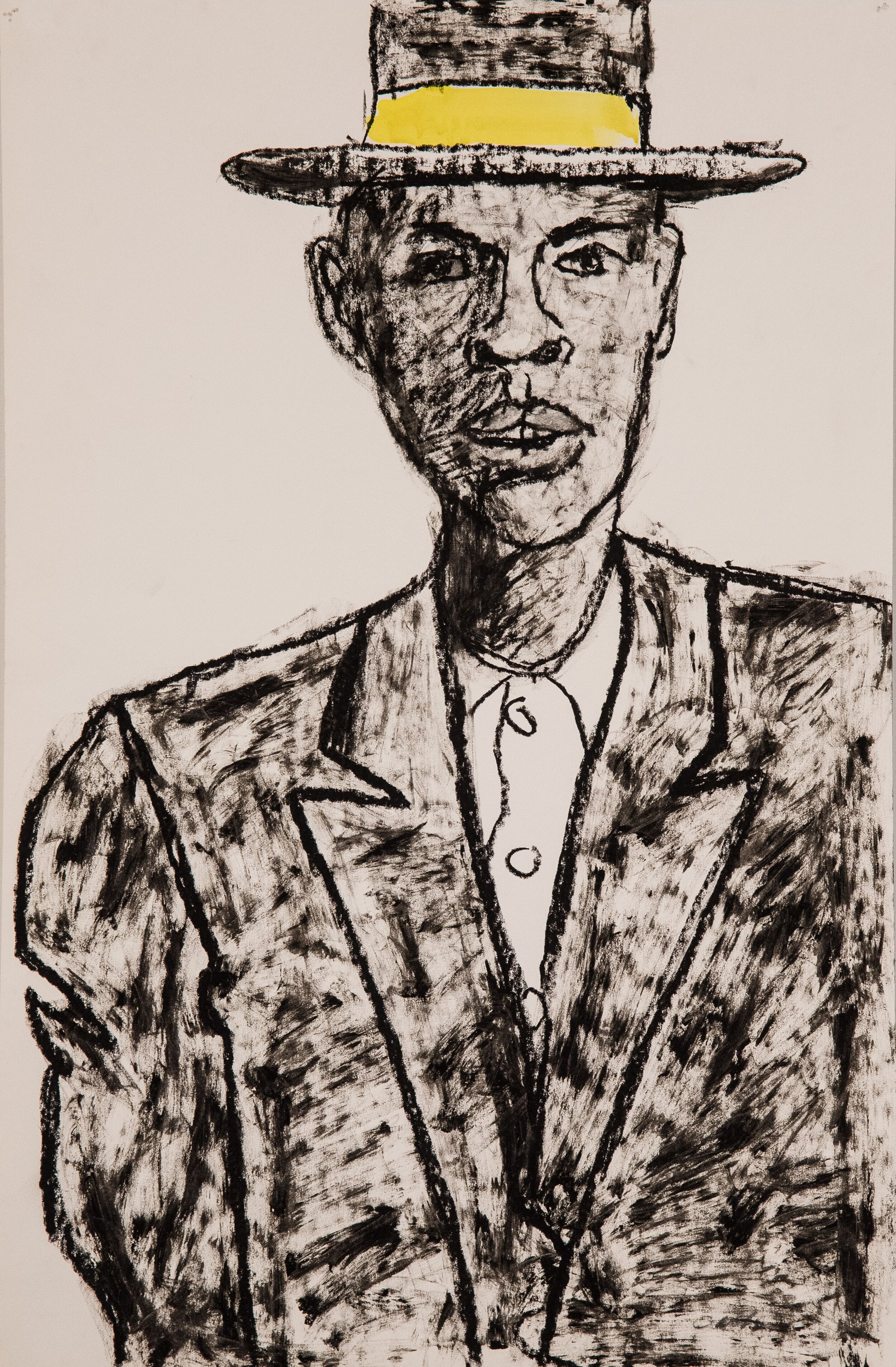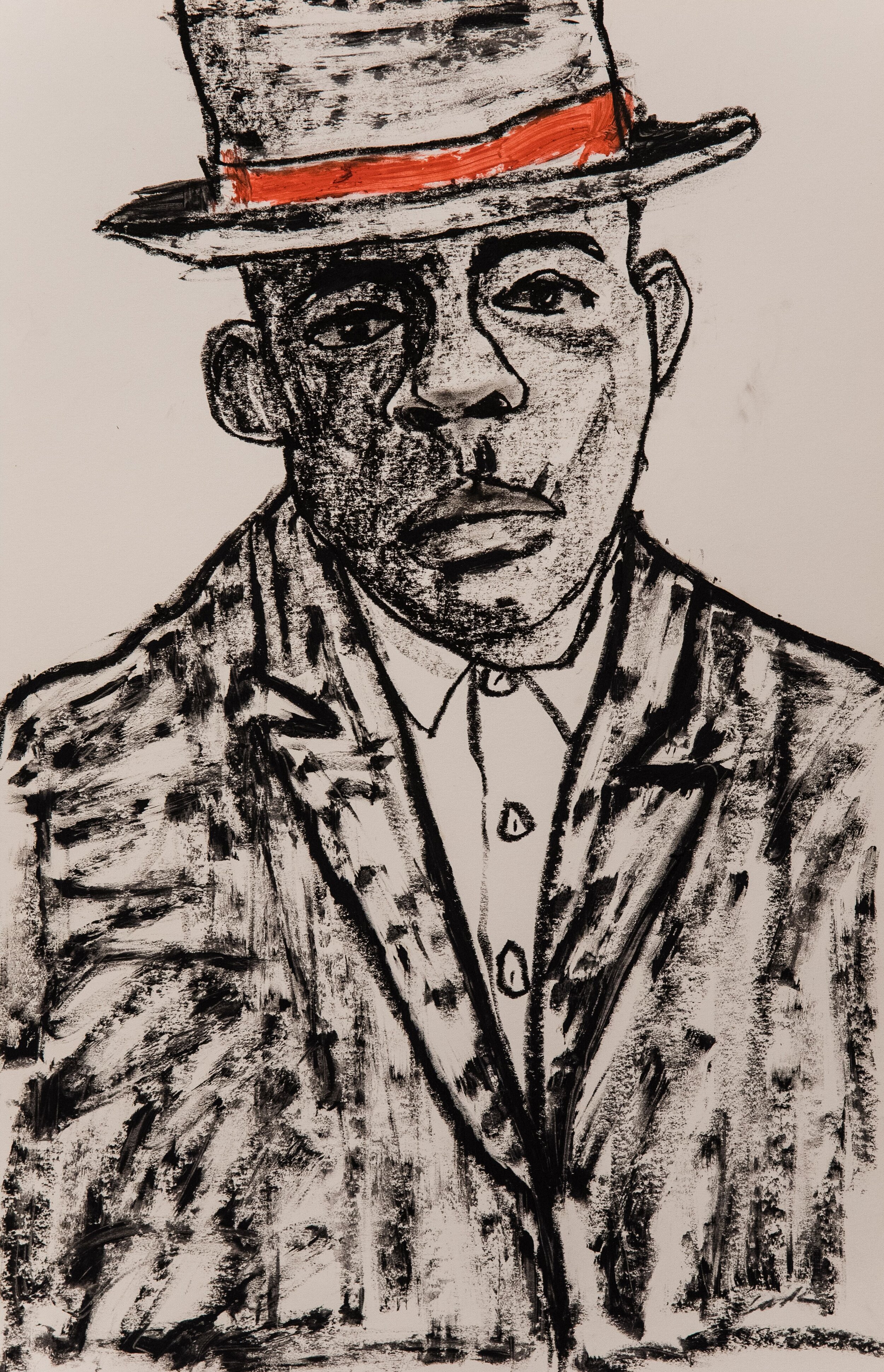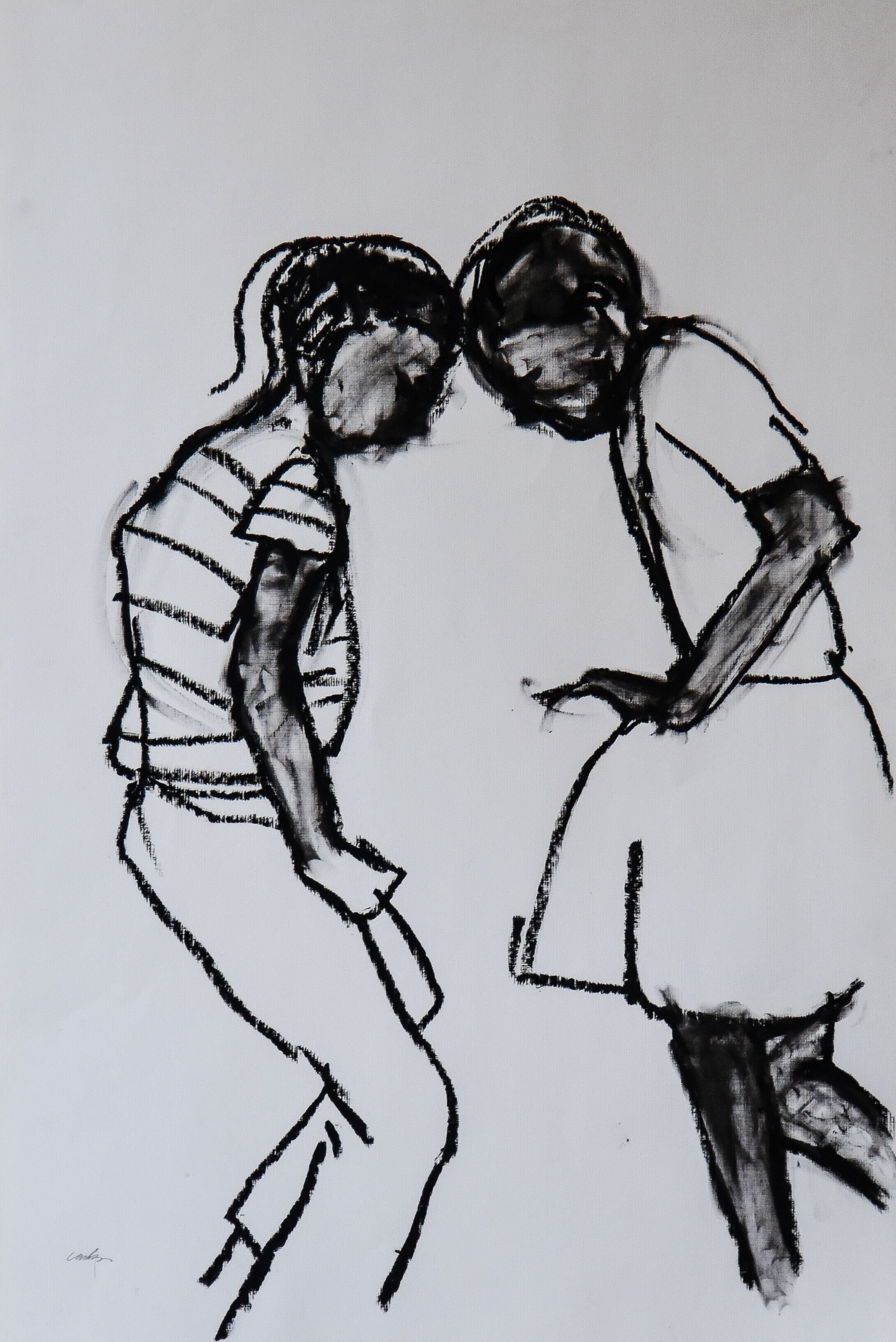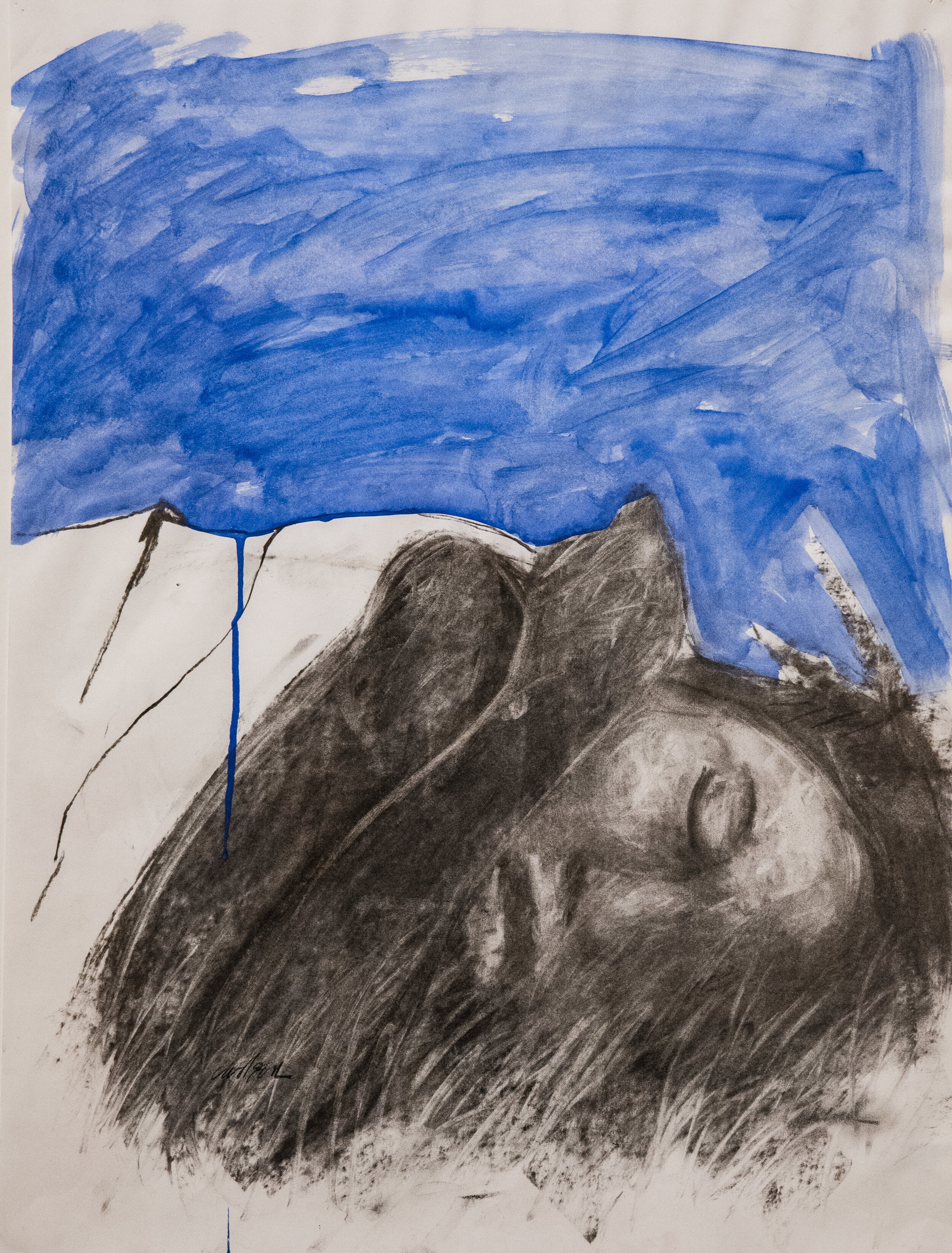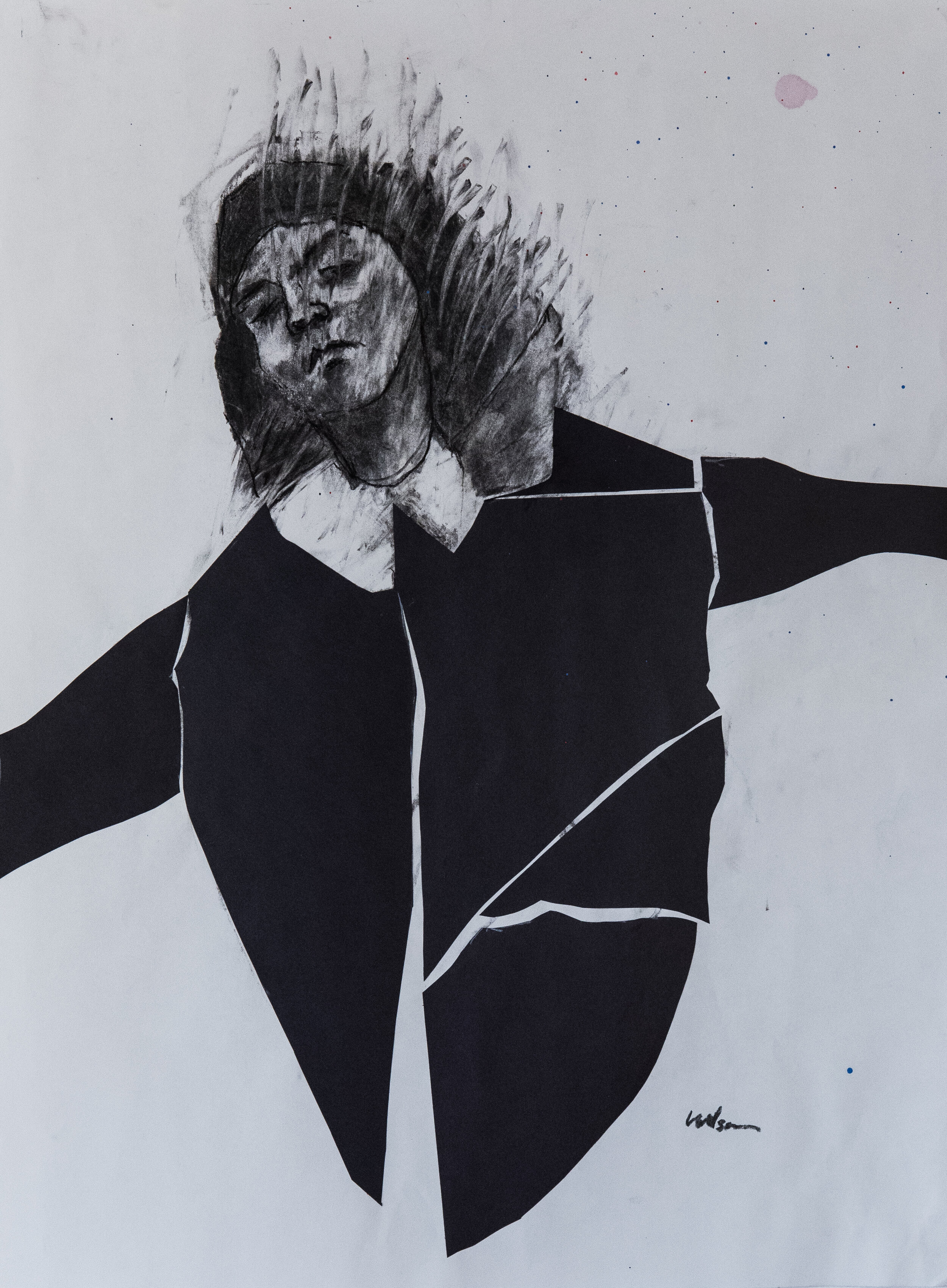BLUES
HEDGE Gallery, Cleveland OH, February - April 2020
1000 Miles From Nowhere, 2020. Oil, charcoal, cotton, and grass on canvas. 6’ x 10’. Price on request.
When I came upon this landscape I entered an archeology that bears the weight of countless breaths and unknown lives. Touched by the heat and the tears, the depth of time, the River, a black scar, and this road to redemption, I stumbled upon the Blues and it became a part of me.
John W. Carlson
Artist Statement
This exhibition is a very personal and spiritual connection to a genre of music that was born out of desperation and the will to survive. In my recent paintings and drawings, it is my intent to strip away the veneer and allow for a deep presence and timelessness to emerge. I chose specific images to convey emotion, energy, gesture and spirituality.
Blues music allowed me to grieve the death of my son in a very personal way. Through this music I felt I was given permission to moan and weep but also to embrace this burden and finally lay it down.
Recently, I took several trips to the Mississippi Delta Region where Blues music was born. I needed to be in and feel the space; the depth, the mystery and spirituality. The most profound visit was in July 2019, where I stood in vast cotton fields that seemed to go on forever and in the middle of lonely black top highways under the scorching southern sun. I experienced full sensory moments through the sound of insects, the unrelenting heat and the smell of the river. I stood at the crossroads of Highways 49 and 61 where the legendary Robert Johnson sold his soul to the devil to be the best bluesman.
The Blues is that place in the soul and space in the heart where the stories of survival, love, loss, joy and desperation come from. In a sense, that is where the subject matter and dialogue in this most recent work has been derived.
His Girl, 2017. Oil and charcoal on canvas. 30” x 40”. Private Collection.
The body itself may not remain, but the body in the memory remains. This is the first painting of the series, chiaroscuro to the threshold of dreaming. It grounds blues in a disembodied innocence, an innocence that seems about to be violated, an innocence that—far better—should carry. His Girl is blues as troubled reverie. It is blues as family, as a daughter to protect. His Girl is precious, seeming to say, Let’s give this child a chance to be a woman. - Carlo Wolff
Muerte de la Madre, 2020. Oil and charcoal on canvas. 48” x 48”. Price on request.
Pure, 2020. Oil, charcoal, and sticks on canvas. 30” x 40”. Price on request.
On a Sea of Forgotten Teardrops, 2020. Oil, charcoal, and driftwood on canvas. 40” x 60”. Price on request.
When I was a young boy it was the first time I heard the term blue blood. I was in literature class, and the way it was explained to me, I remember clearly how estranged I felt: I felt different, low, not one of the counted.
It was also around the same time I happened to be sitting in church and heard from the man in the pulpit that there were two types of people: Jews (God’s chosen people) and Gentile ( I never really knew what they were), but I knew or I was told I was not a Jew. Again, I didn’t feel special, I didn’t feel like I had a community to which I belonged.
I remember the day when someone told me that our blood, all of us - was the colour blue - and that it wasn’t until the oxygen touched it that it turned red. It was maybe in a science class or in a school yard after a game of football.
Years later as I sat in a bar in Clarksdale, Mississippi listening to this spiritual sound, hovering above our heads like an incubus or a succubus, waiting to impregnate our minds with its rituals, that I started to look back inside of my veins and recall the blood conversations. And it was there that I began making a correlation to my blood and this sound.
It was my first time sitting in the home of this sound.
This music which originated in this Deep South of the United States, made and advertised by African-American voices, fingers and culture, reminded me so much of the Negro spirituals, work songs and reggae music I grew up on back in my home of Jamaica.
It suddenly occurred to me that this BLUE fluid that transports oxygen and nutrients to every cell in our body - also transports our pain, joy, struggles wishes and hopes, and sometimes repackages them as song or art, so that we can engage with our neighbours and our community at large.
I have come to understand that the only colour that matters is the one that even when it is touched by oxygen, does not turn to red - it stays blue.
In America I call it the Blues.
It swishes and swashes in everyone’s veins irrespective of our hue. The Blues does not discriminate.
It comes to you like the Holy Trinity, in its three line verse structure, on four bars. Sometimes it swoops in to soothe, to awaken, to remind us of something or someone to keep in memory - and other times it is our escape.
In John’s piece entitled “On a Sea of Forgotten Teardrops,” the Blues sits on top of this broken raft transporting a family as that hopeful third. It is where the Sun sits, it is where their child leaps into hopefulness. The Blues here is the space to escape their wretchedness and it is where John hopes to catapult his viewers, for them to also feel the plight of his collaborators splashed here on his canvas.
In their brokenness, they see the BLUES. - Ruddy Roye
Roll, Jordan, Roll, 2017. Oil, charcoal, and fabric on canvas. 30” x 40”. Price on request.
My Grief, 2010. Oil and charcoal on canvas. 24” x 30”. Price on request.
Dark Was The Night, 2019. Oil, charcoal, and fabric on canvas. Private collection.
Dark Was The Night
Day is done.
The blushing sunset signals those toiling to cease labor.
For a time, Adam’s curse is far from us.
The sky is of the bluest black.
Welcome night.
Now we are free to make in secret.
Tell me a tale—don’t even matter if it’s a lie.
Here, we will sing our sorrows. And laugh our sorrows.
Tonight—in the bluest black—we tell our tales.
Rest is for the weary and the dead
Sunday is for the holy and the praying
For a time, Adam’s curse is far from us.
The sky is of the bluest black.
- Kerry Davis
Nebraska, 2020. Oil, sticks, prairie grass, and newsprint on canvas. Price on request.
Secret Messages, 2018. Oil and charcoal on canvas. 12” x 12”. Price on request.
Baptism, 2019. Oil, charcoal, and fabric on canvas. 24” x 30”. Private collection.
Born Blue
S/he speaks to you through the waves. You pretend you don’t see its trajectory change direction, foamy hills move towards your body—hit rocks in a rhythm that has your attention. Gurgles everything you’ve ever needed to hear. She says the blues are the sounds we heard in nature and sang back to our Mother. I sing back to you. You ignore me, but that song got into you. Hold, envelop, make sure they do not cover my face when they lay my body in this river. It’s a body, it’s a body, it’s a body bag. It’s a swaddle. They carry him out of the sooty shit of life to free—this is the blues. Oshun. An indigo pussy and out he come, unborn. still. An ancestor returns and asks you to complete a task. Burn it blue. Map it—the cartography of a life that has wrestled with mud and muscle, bone and an ash that irritates. Soothe it blue, Slim. We are in this river together. Her mama, whose name I’ve only heard her speak once. My daughter, who hugged me back into life from blue AND your son, your son who lives in the headwaters of the Mississippi and the Cuyahoga; calls to you from the Missouri—this fresh water waiting for the salt of you to return to it. Birth it blue, Slim.
- M. Carmen Lane
Sanctuary, 2019. Oil, charcoal, and wood on canvas. 36” x 48”. Price on request.
Some say when a significant or traumatic event is experienced part of the essence of the
person it happened to is imprinted onto the atmosphere of a place. This is a story about such a
place.
The faded, milk chocolate colored house would never win prizes for it's architecture even
though it was solid and substantial. The house felt ancient to an eight year old girl. In it's
previous lives the house had first been a pre-civil war tavern, a stop on the Underground
railroad and finally her great grandfather's farm. The weight of all this history gave the farm
house a languorous quality, as if it were a giant beast in waiting.
Who had been in the house and why they were there was of most interest to the girl. In the
cellar the air was dank and moist. It smelled of mice and old apples. There were dusty corners
full of long forgotten farm tools. The wide, rough rafters of the coal room had initials carved
randomly across. These carvings were a testimony to the many incarnations of the house. Were
these the initials of slaves hidden on their journey? What echoes of not only fear and anxiety but
also hope did they leave in their wake? Did the house absorb this energy and cast it onto it's
inhabitants? Can that much history not shape the space between walls and floors?
The girl has a very vivid imagination and at night she would see, out of the corner of her eye; a
figure drifting by, toes not touching the floor, eyes wide, finger across lips. Sometimes during
the day the girl would stand at the top of the stairs with eyes closed. Sure that if she
concentrated hard enough she too would float down the steps.
- Catherine Marquardt
Study for (Ida), 2004. Oil on canvas. 16” x 20”. Private collection.
Valley of Revelations, 2018. Oil, charcoal, and newsprint on canvas. 18” x 24”. Private collection.
Cuyahoga
Don’t you see what I see?
Choked and cheated,
don’t you see, the River,
She’s just like me.
Trying hard to breathe—
our dreams
lost in the pavement’s humidity.
Caught in the prevailing wind—
our words land somewhere, anywhere
next to forgotten kin.
We were the freedom fighters, the dream catchers,
the soul chasers, the water walkers.
This polluted valley,
choked and cheated—
I can’t breathe.
Don’t you see what I see?
We are not free.
We are a commodity—
a slave to someone else’s ideology.
We are replaceable.
We are industry.
Choked and cheated,
come on now,
don’t you see what I see?
- Nicki Wilkins
Griot, 2019. Oil and charcoal on canvas. 48” x 48”. Private collection.
(Blue Skies), 2017. Oil and charcoal on canvas. 12” x 12”. Private collection.
Blues Singer, 2019. Oil stick on paper. Private collection.
The blues singer with the cracked voice, is the sound of an emotional cry too powerful for the throat that releases it”. - Brian Eno
Song Drawings
Death Letter Blues, 2020. Oil stick on paper. 21” x 26.5”. Price on request.
Black Cat Bone, 2020. Oil stick on paper. 22” x 30”. Price on request.
Death Letter Blues, 2019. 21” x 26.5”. Price on request.
Dust My Broom, 2020. Oil stick on paper. 17.75” x 30.5”. Price on request.
Going Down To The River, 2020. Oil stick on paper. 18” x 23”. Price on request.
Hear My Train A Comin’, 2019. Oil stick on paper. 9.75” x 26”. Price on request.
Wade IN The Water, 2019. Oil stick on paper. 21.5” x 30.5”. Price on request.
Parchman Famr Blues, 2020. Oil stick on paper. 18” x 23”. Price on request.
Me and the Devil Blues, 2019. Oil stick on paper. 17” x 30”. Price on request.
BLUES: A Review by Joseph Clarke
In the critic’s hands, “raw” is a misleading word. The “rawness” which the metaphor points at is that of pain. The pain of an open wound, the throb of a scrape or burn. “Raw” art transports viewers into a scene of crisis, grief, or trauma that is present and ongoing.
But the production of art takes time. No matter how immediate the experience seems to viewers, it cannot be new to the artist. The experience of immediacy is a careful, time-intensive construction. For every “raw” painting hung, there might be two, three, four drafts in the studio, abandoned after they did not evoke the exact right state of consciousness in crisis. This is true even if the feelings the artist expresses are keenly remembered from her own life, or even if they are ongoing.
That “raw” art is actually carefully crafted does not make it insincere. It makes it art. John W. Carlson’s BLUES is raw. The exhibit takes its name and subject matter from the rustic musical tradition, the first—but by no means last—African American genre to be envied and adopted by the white majority. On a literal level, Carlson’s paintings depict the lands and customs of the southern Blacks who first sang the blues. On a metaphorical level, the wailing mouths and clenched eyes of blues singers are stand-in for universal experiences of pain and grief. Carlson said that his own experience of grief is informed by the death of his child. Blues provided him a way to process and express his grief:
Blues music allowed me to grieve the death of my son in a very personal way. Through this music I felt I was given permission to moan and weep but also to embrace this burden and finally lay it down.
Pain, and more specifically the pain of mourning, are given many forms in BLUES. “Blues Singer” shows a head thrown back with its mouth stretched as far as it will open, revealing a pitch-black interior. In “Secret Messages,” a man’s face contorts; he might be singing, or wincing in pain. Red slashes hover before his mouth, as if the air itself has been cut and left to bleed. Four faceless children stand at their parent’s deathbed in “Muerte de la Madre.” The mother’s wrists twist at unnatural angles, and dark figures hover over the bedroom. “My Grief” is a self-portrait of Carlson himself, staring ahead at nothing. He is numb to the blank world around him; his posture is loose and shaky, and he seems unaware his jaw has drifted open. He pays no mind to the black streaks of rain dripping down his face.
However, Carlson’s personal losses resonate most strongly in “Baptism.” An oil painting with charcoal and textile elements, it depicts two Black men lowering a third figure head-first into a calm, slow river. The figure’s face is smoothed, unlined, and found like a child’s. Their hairline is beneath the water. Their torso is wrapped in a white garment which resembles both a swaddling blanket and a burial shroud. As they are gently lowered below the water, they shut their eyes as if in peaceful sleep. The scene is a baptism, a celebratory initiation into a new religious life. But it could be seen as a riverside funeral. The wrapped figure is still, passive, shut-eyed. The two ministers have wrapped them in clean white garments, and handle their body with loving care. Whether the wrapped figure is being ushered into new life or into death, the paternal figures are there to support them. Love does not cease after the beloved person is gone.
In a departure from his usual fixation on the human figure, Carlson paints the Southern landscapes upon which blues emerged. “1,000 Miles from Nowhere” paints a scene with the sparest possible elements: A white sun; gold sky; brown, flat earth stretching to the horizon; and a black road that narrows as it stretches to a vanishing point. But atop the brown fields, he layers actual balls of raw cotton and leaves of dried grass picked by Carlson during his trips to the Mississippi River Delta. Parts of an environment are incorporated into their depiction.
The fields of cotton and prairie grass populate the plain to the right of the road. On the left, a trio of telephone poles stand. Each of the three vertical column is topped by a crossbar. No telephone lines lay between them. Neglected and left in disrepair, the poles have lost their function. Their cross-like appearance brings to mind crucifixion narrative as told in the gospel of John, in which Jesus was executed between two thieves. In this spot, “1,000 miles from nowhere,” no comforts—be they from the connectivity of community, or religion—can be found. So it is with depression, when familiar consolations do not bring relief from pain.
The pain Carlson explores is individual, the sadness of particular individuals coping with particular losses. Shari Wilkins, founder and executive director of the Cleveland Print Room, documents distress that is social in character. During BLUES run at HEDGE Gallery, Wilkins displayed images from her photo series of houses in her childhood home of Cairo, Illinois. Many of the houses are foreclosed, or simply abandoned and left to rot. Their owners are most likely victims of the economic downturn Cairo has undergone since its loss of industry. The lifeless houses are chilling representations of a dwindling community. But even without knowing the context of Cairo’s deindustrialization, the images are unnerving. They are the opposite of haunted houses—habitable spaces made unwelcoming not by the presence of specters, but the absence of human lives.




